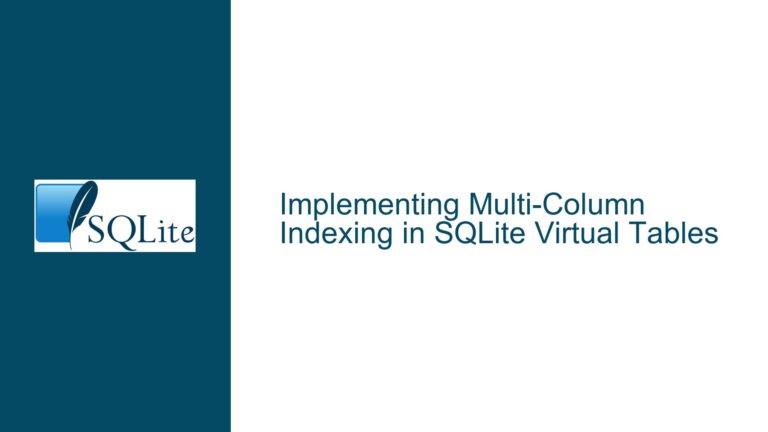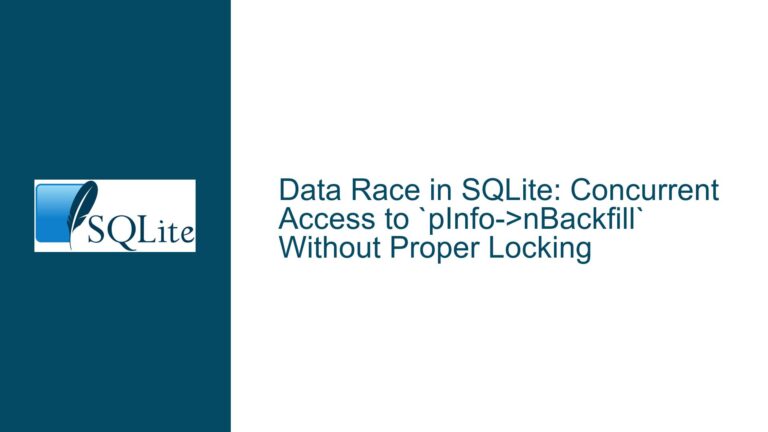Optimizing SQLite Performance: Loading Database into Memory for Faster Queries
Understanding the Need for In-Memory SQLite Databases
When working with SQLite, especially in high-performance environments like Java applications, the need to load a database from disk into memory often arises. This is typically done to speed up query execution times, particularly when dealing with large datasets or complex queries involving joins and pattern matching. The primary goal is to reduce the latency associated with disk I/O operations by leveraging the faster access speeds of RAM.
However, the process of loading an SQLite database into memory is not as straightforward as it might seem. The discussion highlights several methods and considerations, including the use of the restore command, attaching databases, and configuring cache sizes. Each method has its own nuances, advantages, and potential pitfalls, which must be carefully considered to achieve the desired performance improvements.
Common Misconceptions and Pitfalls in Loading SQLite into Memory
One of the most common misconceptions is that using the restore command will automatically load the entire database into memory. As pointed out in the discussion, the restore command is not a standard SQLite command but rather a feature of the SQLite CLI (Command Line Interface). This command is used to restore a database from a backup file, but it does not inherently load the database into memory. Instead, it restores the database to a file on disk, which does not provide the desired in-memory performance benefits.
Another misconception is that attaching a database file to an in-memory database will automatically load all the data into memory. In reality, attaching a database file only loads the table definitions into memory, while the data itself remains on disk. This means that queries will still incur disk I/O overhead, negating the intended performance gains.
Additionally, there is a misunderstanding about the role of the cache_size pragma. While increasing the cache size can improve performance by keeping more data in memory, it does not preload the entire database into memory. Instead, it controls the maximum number of database pages that can be held in memory at any given time. This means that data is only loaded into memory as it is accessed, which may not be sufficient for applications requiring consistent low-latency access to the entire dataset.
Step-by-Step Guide to Loading SQLite into Memory and Optimizing Performance
To effectively load an SQLite database into memory and optimize query performance, follow these steps:
Create an In-Memory Database: Start by creating an in-memory database using the appropriate JDBC connection string. For example, you can use
jdbc:sqlite:file:prod?mode=memory&cache=sharedto create a shared in-memory database. This ensures that all connections to the database share the same memory space, which is crucial for maintaining consistency and performance.Attach the Disk Database: Once the in-memory database is created, attach the disk-based database using the
ATTACHcommand. This allows you to access the tables and data from the disk database within the context of the in-memory database. However, remember that this step only loads the table definitions into memory, not the actual data.Copy Data to In-Memory Database: To load the data into memory, you need to manually copy the tables from the attached disk database to the in-memory database. This can be done using
CREATE TABLE ... AS SELECTstatements. For example:CREATE TABLE in_memory_table AS SELECT * FROM attached_disk_table;This creates a new table in the in-memory database and populates it with data from the disk-based table.
Optimize Cache Settings: Configure the
cache_sizepragma to a value that is large enough to hold the entire dataset in memory. For example, if your database is 2GB in size, set the cache size to at least 500,000 pages (assuming a default page size of 4KB). This ensures that as much data as possible is kept in memory, reducing the need for disk I/O.Preload Data into Cache: To ensure that the data is loaded into memory as soon as the application starts, execute
SELECT *queries on all tables immediately after establishing the connection. This forces SQLite to load the data into the cache, reducing the latency of subsequent queries.Use Transactions Wisely: Enclose related queries within transactions to minimize the overhead associated with starting and committing transactions. This is particularly important for complex queries that involve multiple tables or joins. By grouping queries within a single transaction, you can significantly reduce the time spent on transaction management.
Monitor and Adjust: Continuously monitor the performance of your application and adjust the cache size and other settings as needed. Use tools like JConsole to observe memory usage and query performance, and make adjustments based on the observed behavior.
By following these steps, you can effectively load an SQLite database into memory and optimize query performance for your Java application. Remember that the key to success lies in understanding the nuances of SQLite’s memory management and cache mechanisms, and carefully tailoring your approach to the specific requirements of your application.






